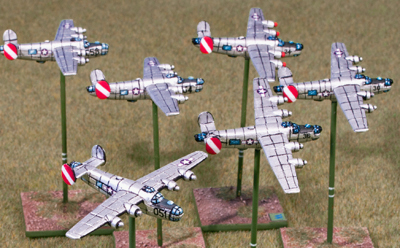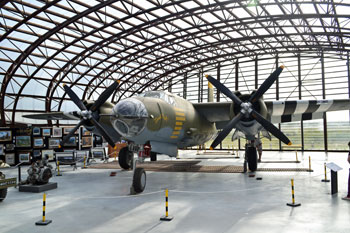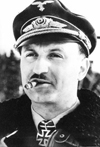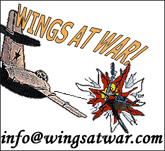Defending the Reich 1944-45
![]()
A mighty fortress
is our God, a bulwark never failing;
Our helper He, amid the flood of
mortal ills prevailing:
For still our ancient foe doth seek to
work us woe;
His craft and power are great, and, armed
with cruel hate,
On earth is not his equal.
Martin Luther
Despite the failure of the Luftwaffe Blitz
against Britain to force a surrender, or at least pave the way for a
decisive land victory, it was still felt that air power could win the
war by attacking industrial and civilian targets. A British Government
report concluded "I
doubt whether Germany will stand 12 or 18 months'
continuous, intensified and increased bombing, affecting, as it must,
her war production, her power of resistance, her industries and her will
to resist (by which I mean morale).
The policy was wholeheartedly endorsed by Air Chief Marshal 'Bomber' Harris, appointed by Churchill to command the fleet of heavy bombers then coming off the ever increasing production lines. The Soviets were also demanding that the Western Allies open a second front to ease pressure on the east and until the US, British and Canadian ground forces were sufficiently strong enough to actually invade occupied Europe a bombing campaign was the only option. When Hitler boasted of "Fortress Europe" President Roosevelt called it a "fortress without a roof".
A Mighty Fortress attempts
to reproduce on the table top the strategy and tactics of the
daylight air campaign.
The US 8th Air Force started to trickle into Britain from 1942. They were keen to get started, equipped as they were with what they considered their wonder weapons; the typically modestly named B-17 Flying Fortress and B-24 Liberator. They were convinced that the heavy armament and generous amounts of armour would ensure that (this time definitely) "the bomber will always get through".
At the start of 1943 it was agreed between the Allies that the strategic bombing of Germany would be a central part of the overall strategy for victory, the bombing part of which was called Operation Pointblank. The British would attack at night with their less well protected aircraft but bigger bomb loads whereas the USAAF, confident in the accuracy and power of their flying fortresses, would attack during the day.
The initial confidence of the 8th Air Force was soon shattered by the horrendous losses suffered by the unescorted bombers, massacred by the Luftwaffe's expert fighters and heavily armed twin-engine Bf 110 and Me 410 'destroyers'. Unguided rockets, which out-ranged the bombers own machineguns, were used to break up formations allowing the heavy fighters to pick off individual bombers. Daylight deep penetration missions were halted until a suitable long range escort fighter could be produced.
This strategy was maintained and in the two months following D-Day the Luftwaffe lost more fighters than they'd lost on the Eastern Front in the previous two years. Tactical support for the invasion was provided by the Allied Expeditionary Air Force made up of 173 fighter/fighter-bomber and 59 light and medium bomber squadrons. For the most part these would be based in France soon after the landings. During the Normandy campaign both USAAF and RAF heavy bombers were also used against tactical targets, softening up German front line troops just before an attack went in, though with high risk to the Allied army's own front line troops.
With the advent of V-1 flying-bomb attacks in June 1944 Allied command gave the launch sites the second highest target priority after support for the D-Day landings. Following the Normandy campaign airpower was used to help mop up the German armies trapped in the Falaise pocket.
A typical mass raid in May, targeting Germany's synthetic fuel and refining plants as part of the Allies newly instigated Oil Plan, consisted of around 900 bombers escorted by a similar number of fighters. These were confronted by virtually the whole of the Luftwaffe's fighter defence in the west, just under 500 planes. 46 bombers and 7 escorting fighters were shot down but the Germans lost 65 fighters and three of their top aces were killed or wounded. Hitler was warned by Albert Speer "If they persist at it this time, then we will soon no longer have any fuel production worth mentioning."
By the end of 1944, the introduction of more and improved fighters, including the superlative P-51D Mustang able to escort the bombers all the way to Berlin and beyond, the Allies gradually gained complete air supremacy. The German twin-engine 'destroyers' had to be withdrawn as they proved easy pickings for the nimble single-seaters. For the Luftwaffe lack of fuel increasingly curtailed training, though there were never enough fighters to cover the whole of Western Europe anyway. German aircraft production was plagued by a lack of urgency and resources throughout the war, which was expected to be short, and the Nazi leadership were far more interested in revenge attacks (necessitating bombers) rather than what they perceived as showing weakness by producing fighters for defence. Allied bombing of aircraft factories and fuel production exacerbated the issues. The new crop of Luftwaffe pilots had little chance against the Allied onslaught.
 Hitler's last roll of the dice in the
west, the Ardennes Offensive,
included the Luftwaffe's swansong, given the code name of Bodenplatte.
This was an audacious plan to attack Allied airfields in Belgium and
Holland at first light on New Year's Day. Over 800 fighters, including Me 262s were to try
and eliminate the Allied air forces whilst they were still on the
ground. Though the Allies suffered significant damage German losses were catastrophic. Few of the Allied planes had crew in them and those
destroyed were replaced within weeks. Most of the downed German pilots were
killed or captured.
Hitler's last roll of the dice in the
west, the Ardennes Offensive,
included the Luftwaffe's swansong, given the code name of Bodenplatte.
This was an audacious plan to attack Allied airfields in Belgium and
Holland at first light on New Year's Day. Over 800 fighters, including Me 262s were to try
and eliminate the Allied air forces whilst they were still on the
ground. Though the Allies suffered significant damage German losses were catastrophic. Few of the Allied planes had crew in them and those
destroyed were replaced within weeks. Most of the downed German pilots were
killed or captured.
Despite the advent of heavily armed and armoured single-engine bomber destroyers and the first jet fighters, a forlorn effort to counter the Allies with quality rather than quantity, the Luftwaffe was all but finished by the start of 1945. By then the USAAF alone could field over 7,000 combat aircraft against the fast dwindling Luftwaffe whose inventory was reduced to less than half this. In reality, this was a battle the Germans could not win. Their introduction of technically advanced types like the Me 262, Ar 234 and Fw 190D came too late, and it could be argued that the resources diverted in developing them would have been better spent on producing many more of the existing types such as the Fw 190. The few remaining experienced pilots were diverted to fly these 'wonder weapons' further diluting the standard of crews operating the more conventional types.
The policy was wholeheartedly endorsed by Air Chief Marshal 'Bomber' Harris, appointed by Churchill to command the fleet of heavy bombers then coming off the ever increasing production lines. The Soviets were also demanding that the Western Allies open a second front to ease pressure on the east and until the US, British and Canadian ground forces were sufficiently strong enough to actually invade occupied Europe a bombing campaign was the only option. When Hitler boasted of "Fortress Europe" President Roosevelt called it a "fortress without a roof"
The US 8th Air Force started to trickle into Britain from 1942. They were keen to get started, equipped as they were with what they considered their wonder weapons; the typically modestly named B-17 Flying Fortress and B-24 Liberator. They were convinced that the heavy armament and generous amounts of armour would ensure that (this time definitely) "the bomber will always get through".
At the start of 1943 it was agreed between the Allies that the strategic bombing of Germany would be a central part of the overall strategy for victory, the bombing part of which was called Operation Pointblank. The British would attack at night with their less well protected aircraft but bigger bomb loads whereas the USAAF, confident in the accuracy and power of their flying fortresses, would attack during the day.
The initial confidence of the 8th Air Force was soon shattered by the horrendous losses suffered by the unescorted bombers, massacred by the Luftwaffe's expert fighters and heavily armed twin-engine Bf 110 and Me 410 'destroyers'. Unguided rockets, which out-ranged the bombers own machineguns, were used to break up formations allowing the heavy fighters to pick off individual bombers. Daylight deep penetration missions were halted until a suitable long range escort fighter could be produced.
|
For the impending invasion, control of the USAAF in Britain was temporarily handed to Eisenhower as the strategic campaign was suspended in order to concentrate on Overlord. The transport infrastructure of France was targeted; railway hubs, bridges, rolling stock etc. being hit. Also included were attacks on coastal defences, RAF heavy bombers joining the Americans in daylight raids. Targets outside of the campaign area were also hit as part of Operation Fortitude, the deception part of Overlord. In spring 1944 focus turned to direct preparation for D-Day. James Doolittle took over command of a reorganised 8th AF and maintained that the priority was to shatter the Luftwaffe's strength and that the only way to achieve this was to beat it on the battlefield. To this end he instigated a slew of missions, commonly known as 'Big Week', in which for the first time the fighters were tasked with air superiority rather than having to endure the shackles of escort duty. |
 |
| B-26 at the Utah Beach Museum, Normandy |
This strategy was maintained and in the two months following D-Day the Luftwaffe lost more fighters than they'd lost on the Eastern Front in the previous two years. Tactical support for the invasion was provided by the Allied Expeditionary Air Force made up of 173 fighter/fighter-bomber and 59 light and medium bomber squadrons. For the most part these would be based in France soon after the landings. During the Normandy campaign both USAAF and RAF heavy bombers were also used against tactical targets, softening up German front line troops just before an attack went in, though with high risk to the Allied army's own front line troops.
With the advent of V-1 flying-bomb attacks in June 1944 Allied command gave the launch sites the second highest target priority after support for the D-Day landings. Following the Normandy campaign airpower was used to help mop up the German armies trapped in the Falaise pocket.
A typical mass raid in May, targeting Germany's synthetic fuel and refining plants as part of the Allies newly instigated Oil Plan, consisted of around 900 bombers escorted by a similar number of fighters. These were confronted by virtually the whole of the Luftwaffe's fighter defence in the west, just under 500 planes. 46 bombers and 7 escorting fighters were shot down but the Germans lost 65 fighters and three of their top aces were killed or wounded. Hitler was warned by Albert Speer "If they persist at it this time, then we will soon no longer have any fuel production worth mentioning."
By the end of 1944, the introduction of more and improved fighters, including the superlative P-51D Mustang able to escort the bombers all the way to Berlin and beyond, the Allies gradually gained complete air supremacy. The German twin-engine 'destroyers' had to be withdrawn as they proved easy pickings for the nimble single-seaters. For the Luftwaffe lack of fuel increasingly curtailed training, though there were never enough fighters to cover the whole of Western Europe anyway. German aircraft production was plagued by a lack of urgency and resources throughout the war, which was expected to be short, and the Nazi leadership were far more interested in revenge attacks (necessitating bombers) rather than what they perceived as showing weakness by producing fighters for defence. Allied bombing of aircraft factories and fuel production exacerbated the issues. The new crop of Luftwaffe pilots had little chance against the Allied onslaught.
 Hitler's last roll of the dice in the
west, the Ardennes Offensive,
included the Luftwaffe's swansong, given the code name of Bodenplatte.
This was an audacious plan to attack Allied airfields in Belgium and
Holland at first light on New Year's Day. Over 800 fighters, including Me 262s were to try
and eliminate the Allied air forces whilst they were still on the
ground. Though the Allies suffered significant damage German losses were catastrophic. Few of the Allied planes had crew in them and those
destroyed were replaced within weeks. Most of the downed German pilots were
killed or captured.
Hitler's last roll of the dice in the
west, the Ardennes Offensive,
included the Luftwaffe's swansong, given the code name of Bodenplatte.
This was an audacious plan to attack Allied airfields in Belgium and
Holland at first light on New Year's Day. Over 800 fighters, including Me 262s were to try
and eliminate the Allied air forces whilst they were still on the
ground. Though the Allies suffered significant damage German losses were catastrophic. Few of the Allied planes had crew in them and those
destroyed were replaced within weeks. Most of the downed German pilots were
killed or captured.Despite the advent of heavily armed and armoured single-engine bomber destroyers and the first jet fighters, a forlorn effort to counter the Allies with quality rather than quantity, the Luftwaffe was all but finished by the start of 1945. By then the USAAF alone could field over 7,000 combat aircraft against the fast dwindling Luftwaffe whose inventory was reduced to less than half this. In reality, this was a battle the Germans could not win. Their introduction of technically advanced types like the Me 262, Ar 234 and Fw 190D came too late, and it could be argued that the resources diverted in developing them would have been better spent on producing many more of the existing types such as the Fw 190. The few remaining experienced pilots were diverted to fly these 'wonder weapons' further diluting the standard of crews operating the more conventional types.
 |
Whether the appalling consequences for the civilian population, and Germany as a whole, was worth the difference the bombing campaign made to the war is still debated now. Perhaps the last line should go to 'Bomber' Harris; "The Nazis entered this war under the rather childish delusion that they were going to bomb everyone else, and nobody was going to bomb them. At Rotterdam, London, Warsaw and half a hundred other places, they put their rather naive theory into operation. They sowed the wind, and now they are going to reap the whirlwind." |
| Viermot ace Walter Dahl |
Click on the links below for more information
